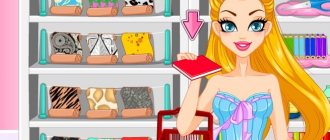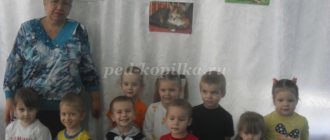Card index of kindness games for children 3-4 years old
Card index of games for goodwill
for children 3-4 years old
“The sun illuminates friendship”
Goal: developing children’s friendliness towards each other, the desire to please.
A circle is drawn on a piece of paper. Children paint their palms with gouache and print a palm in a drawn circle, with whom they would like to create a couple next to.
"Compliments"
Goal: develop emotional sensitivity, practice verbal communication skills. Sitting in a circle, everyone joins hands. Looking into your neighbor's eyes, you need to say a few kind words to him, praise him for something. The receiver nods his head and says: “Thank you, I’m very pleased!” Then he gives a compliment to his neighbor, the exercise is carried out in a circle. Some children cannot give a compliment; they need help. Instead of praising, you can simply say “delicious”, “sweet”, “floral”, “milk” word. If a child finds it difficult to give a compliment, do not wait for his neighbor to be sad, give the compliment yourself.
"Friendship begins with a smile"
Goal: to practice nonverbal communication skills. Children sitting in a circle hold hands, look into their neighbor's eyes and silently smile at each other.
"Friends"
Goal: to create a sense of unity, cohesion, and the ability to act in a team. Children stand in a circle. 1 verse. Here you are, here I am (stretch your palms forward), You can’t quarrel (they shake a finger at the center)! Here you are, here I am (stretch your palms forward, then place them on your chest), Together we are friends (hold hands)! Here you are, here I am (stretch your palms forward, then put them on your chest) You can’t quarrel (they shake a finger at each other) Here you are, here I am (stretch your palms forward, then put them on your chest) Together we are friends (hug each other friend).
"Animal Piano"
Goal: develop the ability to cooperate with each other. Children sit in one line (it turns out to be a piano keyboard). The presenter gives each child cards with images of animals, whose voices will sound “keys” (cat, dog, pig, mouse, etc.). The presenter, that is, the “pianist,” touches the children’s heads (“plays the keys”). And the “keys” each make their own sound. You can also play on your knees – the keys. Then you can also introduce sound volume into the game. If the pianist touches the key lightly, it sounds very quiet, barely audible, if more strongly, it sounds loud. If it is strong, then the “key” is to speak loudly.
"Merry little engine"
Goal: To develop the cohesion of a group of children, the ability to overcome obstacles together. The presenter is a “locomotive” who must make up a train of children. The guys are assigned the role of “carriages”. The “locomotive” drives up to each of the “cars” in turn and gets acquainted with it. When naming a name, you can ask the guys to come up with one good word for themselves, for example: “I’m the funny little engine Lena, and who are you?” - And I’m a beautiful trailer, Sasha. - Let's move on together. - Go. The children go after the next “car”, and so on until a whole funny train is assembled. Then the children stand one after another. In this position, they overcome various obstacles: Throughout the entire exercise, children should not become detached from their partner. The train that arrives at the finish line in full strength is awarded (“The engine and the carriages were very attentive, took care of each other and therefore did not lose anyone along the way”).
Speech games in the 2nd junior group
Card index “Didactic games in the 2nd junior group
“Introduction to sound reality and the development of voluntary hand movements”
"Guess what it sounds like"
Goal : To introduce children to the sounds of the world around them, to isolate and recognize them.
Progress: The teacher shows the objects one by one and demonstrates how they sound. Then the teacher offers to solve riddles. He closes the screen and acts with different objects, and the children recognize which objects the different sounds belong to. Explains that there are many sounds in the world and they all sound differently.
"Watch"
Goal: To develop children's speech attention.
Progress: V-l: Listen to how the clock ticks: “Tick-tock, tick-tock,” how the clock strikes: “Bom-bom...”. In order for them to walk, you need to start them: “tri-truck...”! .
- Let's wind up a big clock (children repeat the corresponding sound combination 3 times); Our clock goes and first ticks, then strikes (sound combinations are repeated by the children 5-6 times).
- Now let’s wind up the small clock, the clock goes and sings quietly, the clock strikes very quietly (the children imitate the movement and ringing of the clock with their voices each time).
"Bear cubs eat honey"
Goal : To develop the articulatory apparatus of children.
Progress: The teacher tells the children that they will be bear cubs, and bear cubs really love honey. He suggests bringing your palm closer to your mouth (with your fingers) and “licking” the honey - the children stick out their tongues and, without touching their palm, imitate that they are eating honey. Then, lifting the tip of the tongue, remove it. (Mandatory demonstration of all actions by the teacher.)
The game is repeated 3-4 times.
Then the teacher says: “The bear cubs are full. They lick the upper lip (show), lower lip (show). They stroke their tummies, saying: “Oooh” (2-3 times).
"The Frog and the Little Frogs"
Goal: To develop children's speech attention.
Progress: The teacher divides the children into two groups: large and small frogs. He says: “Big frogs jump into the pond, swim in the water and croak loudly: “Kva-kva” (children imitate that they are swimming and croak loudly)
Little frogs also jump into the pond, swim, and croak quietly (children imitate the actions and croak quietly). All the frogs got tired and sat down on the sand on the shore.” Then the children change roles and the game is repeated.
"Let's feed the chicks"
Goal: To develop the speech apparatus of children.
Progress: (I am the mother bird, and you are my little chicks. The chicks are cheerful, they squeak: “pee-pee,” and flap their wings. The mother bird flew for tasty crumbs for her children, and the chicks fly merrily and squeak The mother flew in and started feeding her babies (the children squat down, raise their heads up, the chicks open their beaks wide, they want tasty crumbs.
(The teacher tries to get the children to open their mouths wider.) The game is repeated 2-3 times.
"At the doctor"
Goal: To develop the articulatory apparatus of children.
Progress: The doll is a doctor. She wants to see if the children's teeth hurt.
Q: Show the doctor your teeth (the teacher with the doll quickly walks around the children and says that everyone has good teeth. Now the doctor will check if you have a sore throat. Whoever she approaches will open his mouth wide (the children open their mouths wide).
The doctor is happy: no one has a sore throat.
"Guess what it sounds like"
Goal : Continue to isolate and recognize the sounds of individual musical instruments.
Progress : The teacher shows musical instruments one by one and demonstrates how they sound. Then the teacher offers to solve riddles. He closes the screen and acts with different instruments, and the children recognize what different sounds belong to.
"Recognize by voice"
Goal: To clarify and reinforce the correct pronunciation of sounds.
Progress: The teacher shows the toys and asks who it is, asks to say how it screams. The screen is closed and one subgroup of children takes the toys and takes turns speaking for their animals. Another group guesses who shouted.
“Who lives in the house? »
Goal: To reinforce the correct pronunciation of sounds. Develop children's speech breathing.
Progress: (The teacher shows a picture of a dog). Who is this? The dog barks loudly: “aw-aw.” And who is this? (children's answers) The puppy barks quietly (children repeat the sound combination 3-4 times). (The teacher shows a picture of a cat). Who is this? The cat meows loudly: “Meow-meow.” And who is this? (children's answers) The kitten meows quietly.
Let the little animals go home (the pictures are put away behind the cubes). Guess who lives in this house: “av-av” (pronounced loudly? (children’s answers) That’s right, a dog (shows a picture). How did she bark? (children’s answers).
Guess who lives in this house: “meow-meow” (pronounced quietly? How did the kitten meow?
Similarly, children guess who lives in other houses and repeat sound combinations several times.
“Who is screaming? »
Goal: To develop children's speech attention.
Progress: The mother bird had a little chick (puts out pictures). His mother taught him to sing. The bird sang loudly: “chirp - chirp” (children repeat the sound combination). And the chick answered quietly: “chirp-chirp” (children repeat the sound combination 3-4 times). The chick flew and flew far away from its mother (moves the picture of the chick further away). The bird is calling its son. What does she call him? (Children, together with the teacher, repeat the sound combination). The chick heard its mother calling him and chirped. How does he tweet? (Children say quietly). He flew to his mother. The bird sang loudly. How?
"Call Your Mom"
Goal: To reinforce the correct pronunciation of sounds. Develop intonation expressiveness.
Progress: All children have object pictures with baby animals. Educator: “Who is your picture, Kolya? (chicken) Who is the chicken's mother? (chicken) Call your mother, chicken. (Peep-pee-pee) The teacher imitates the clucking of a chicken and shows a picture.
The same work is carried out with all children.
"Answer me"
Goal: To reinforce the correct pronunciation of sounds. Develop intonation expressiveness.
Progress: Educator: This is a goat (showing a picture). How is she screaming? Who is her cub? How does he scream? This is a sheep (show picture). How does she bleat? And how does her baby lamb scream? etc. Pictures are displayed on flannelgraph.
The teacher hands out pictures of animals and birds to the children. The cubs are walking (children leave the tables, nibble grass, nibble crumbs. Whose mother or whose father will call the cub. He must shout - answer them - and run - put the picture next to them.
The teacher pronounces the cry of an animal or bird. The child with the cub depicted makes sounds and places the picture on the flannelgraph.
on speech development
"WONDERFUL BAG"
Goal: focus on the gender of a noun when defining an object by its characteristics.
Materials: hare, carrot, cucumber, apple, tomato, bag.
Let’s tell the children something like this: “A hare came to our kindergarten. Running bunny, what's in your bag? Can I have a look? What is this? (Carrot.) What carrot? (Long, red.) Put the carrots on the table. And what's that? (Cucumber.) What cucumber? (In the same way we take out a tomato, apple, etc.)
Now the hare wants to play with you. He hid all the vegetables and fruits in a bag. The bunny will put his paw into the bag, take a vegetable or fruit and tell you about it, and you must guess what the bunny has in his paw. Listen carefully. It is long and red. What is this? (Carrot.) It is green and long. What is this? (Cucumber.) It is round and red. What is this? (Apple.) It is round and red. What is this? (Tomato.)"
If the children answer the last two questions incorrectly, we repeat, emphasizing the pronoun in our voice: “Listen again. It is round and red. It's round and red.
Now find and put vegetables in the bag. What's left? (Apple.) Apples are fruits. Thank you, hare, for coming to us. Goodbye".
"MULTI-COLORED CHEST"
Goal: learn to focus on endings when agreeing words in gender.
Materials: chest, object pictures: egg, cookies, jam, apple, towel and other objects designated by neuter and feminine nouns, according to the number of children.
Let's put a chest with pictures on the table. We will invite the children to take out the pictures one at a time, while asking questions: “Which egg? Which
matryoshka? Etc. The interrogative pronoun agrees with the noun and helps the child correctly determine the gender of the latter.
If the pictures show 2-3 objects, the game will take on a new meaning: the child will be able to practice forming the nominative plural forms of nouns.
"TEREMOK"
Goal: focus on the ending of a verb in the past tense when agreeing it with a noun.
Materials: wooden house, toy animals: mouse, frog, bunny, fox, wolf, bear.
Let's put a tower on the carpet. We will place the animals near the tower. We will tell a fairy tale, encouraging children to take part in the telling.
— There is a tower in the field. She ran to the tower... who? That's right, mouse. (Children give hints based on the meaning of the verb and its ending.) “Who lives in the little house?” Nobody here. The mouse began to live in the little house.
A frog galloped up to the tower. Etc. In conclusion, let's summarize:
- Listen to how we say: the frog galloped, and the bunny galloped; The fox came running, and the wolf came running.
“WHAT’S MISSING?”
Purpose: to practice the formation of genitive plural forms of nouns.
Materials: pairs of objects: nesting dolls, pyramids (large and small), ribbons (of different colors and different sizes - long and short), horses, ducklings, Pinocchio, bag.
Pinocchio appears in front of the children with a bag. He says that he brought toys for the guys. Children look at toys. They call them. They put it on the table.
We comment:
- What is this? Matryoshka. Let's see what's inside the nesting doll. Another matryoshka. Place them next to each other. Vova, now take out the toy. What is this? (Pyramid.) Is there another pyramid? Etc.
- Remember what items are on the table. There are pyramids, nesting dolls, and ducklings. Pinocchio will play with you. He will hide toys, and you will have to say which toys are gone: nesting dolls, pyramids, ducklings or something else.
Three pairs of objects remain on the table: nesting dolls, pyramids, horses. Children close their eyes. We hide the nesting dolls and put ribbons in their place. (“Who’s missing?”) Then we hide the ribbons and put pyramids in their place. (“What’s missing?”) Etc. Finally, we remove all the toys and ask: “Which toys are missing?”
“WHERE ARE OUR HANDS?”
Purpose: to practice the formation of genitive plural forms of nouns.
Children sit on chairs. Let's address them, inviting them to a joke or a game with intonation:
Where are our pens? Our pens are gone! (We hide our hands behind our backs. Children do the same.) Here are our hands! (We show our hands and play with our fingers.)
- Where are our legs? Our legs are gone! (Children hide their legs under the chair.) Here are our legs! (They stomp their feet.)
- Where are our pens? What's missing? (Pens.) Here are our pens! - Where are our legs? What's missing? (Legs.) Here are our legs!
The game is repeated 2-3 times.
"LOTTO"
Purpose: to practice the formation of plural forms of nouns (in the nominative and genitive cases).
Materials: pictures depicting objects in the singular and plural (matryoshka - nesting dolls, bucket - buckets, wheel - wheels, ring - rings, etc.).
We distribute pictures to the children, keeping the paired ones. We explain the conditions of the game:
- This is a game of attention. I will show pictures. Each picture shows a toy. Anyone who has a picture with the same toys should quickly say so. For example, I have a wheel. And Vera has wheels. Faith must quickly say, “I have wheels,” or “I have many wheels.” Toys must be named.
The one who hesitates gives his picture to an adult. If the child quickly and correctly names the toy, we give our picture to him.
At the end of the game, the losers (who do not have pictures on their hands) are offered comic tasks: jump on one leg, jump high, sit down three times, etc. We come up with tasks together with the children.
"ORDERS"
Purpose: to practice the formation of imperative forms of the verbs to jump, to go.
Materials: truck, mouse, bear.
We bring a truck and a mouse and a bear into the room. We address the children:
— Do you want the mouse and the bear to ride in a truck? If you want, ask them. You have to say: “Bear, go!” You can also ask the mouse and the bear to jump: “Mouse, jump!” (Requests are accompanied by actions with toys.)
- Oleg, who do you want to ask, a mouse or a bear? What will you ask for?
The game continues until the children's interest in it runs out.
“BEAR, LEAN!”
Purpose: to practice the formation of imperative forms of the verbs lie, sing.
Materials: teddy bear (voiced toy).
A bear cub comes to visit the children. We tell you that he knows how to carry out orders. You can ask the bear: “Bear, lie down on your side... lie down on your back... lie down on your tummy.” He can also sing, you just need to ask: “Bear, sing!” (The story is accompanied by actions with the toy.)
At the request of the children, the bear cub performs various tasks. If the child finds it difficult to formulate the task, we ask leading questions: “Do you want the bear to lie down? On the tummy or on the back? Let’s say together: bear, lie down on your tummy.”
You can give the bear cub other tasks: go (down the hill), jump, dance, write a letter, etc.
"HIDE AND HIDE"
Goal: correctly use prepositions with spatial meaning in speech (in, on, about, under, before).
Materials: truck, bear, mouse.
The bear and the mouse are visiting the children again. The guests began to play hide and seek. The bear leads, and the mouse hides. We invite children to close their eyes. We say:
— The mouse hid. Open your eyes. The bear is looking: “Where is the mouse? He’s probably under the car?” No. Where is he, guys? (In the cockpit.) Look where he got into!
Close your eyes again, the mouse will hide again. (We put the mouse on the cabin.) Where is the mouse? Guys, tell the bear!
In the same way, children, together with the teddy bear, look for a mouse that is hiding under the car, near the car, in front of the car.
Games and exercises with grammatical content can be included in group lesson scenarios, or can be carried out at the request of children with small subgroups during leisure hours. You can organize games with children, with the help of which they would learn to correlate the producing and derivative words. This is done on the basis of nouns denoting animals and their young. The formation of methods of verbal word formation is closely related to form formation. It is carried out in outdoor games, dramatization games, and special didactic games.
"LOST"
Goal: match the name of the animal with the name of the baby.
Materials: toy house, animals (toys): duck and duckling, hen and chick, goat and kid, cow and calf, horse and foal.
Let's place adult animals around the room. Their cubs are on the carpet in the house. Let's invite the children to find out who lives in the house.
- Let's get a look. Quack-quack-quack - who is it? Duck? We take out the toy from the house. Is the duck big or small? Small? This, guys, is a duckling. Little duckling. And the duck is his mother. Help the duckling find his mother duck. Vasya, take the duckling. Look for the duck.
- Whose voice is this - pi-pi-pi? Who is this? (We take out the chicken.) Who is the chicken's mother? How does a chicken cackle? How does the chicken respond? Look, Olya, for the chicken, the chicken’s mother.
The rest of the characters are played out in a similar way. When all the babies have mothers, the adults and cubs are placed together. Let the children look at them, say the words: duck - duckling, hen - chicken, etc. Then the animals leave by car to visit other children.
"WHOSE'S VOICE?"
Goal: to distinguish between adult animals and young animals by onomatopoeia, to correlate the names of an adult animal and its young.
Materials: toys: mouse and little mouse, duck and duckling, frog and baby frog, cow and calf.
Animals come and visit children. The animals want to play. Children must guess whose voice they heard.
- Moo-oo - who moos like that? (Cow.) Who moos lowly? (Calf.)
Kwa-kwa—whose rude voice is this? And who croaks thinly? The frog is large and croaks in a rough voice. And her cub croaks thinly. Who is the baby frog?
The rest of the toys are played in the same way. After the game, children can play with toys. To receive a toy, the child must call it correctly (“Frog, come to me!”, “Duckling, come to me!”).
"HOUSES"
Goal: use the names of baby animals.
Materials: tray with toys: squirrels, hares, ducklings, mice, etc. - according to the number of children, building material.
We bring a tray of toys into the room. We say that children should build houses for the kids. Everyone must first decide for whom he will build a house, and correctly ask an adult: “Please give me a duckling (little squirrel).”
If necessary, you need to suggest the whole word or just the beginning and ask the child to repeat the name.
We lay out building material on the carpet. Children build houses for their animals and play.
"FRIENDLY GUYS"
Goal: to correlate the names of adult animals with the names of their babies, to activate the names of baby animals in speech.
Materials: squirrel and fox.
Let's explain to the children the content of the game:
— Now we’ll play the game “Friendly Guys.” Get into pairs. Now line up in two columns. The first column is squirrels, the second is fox cubs. Here are your houses (we place chairs at different ends of the room, on which we sit the squirrel and the fox). If you hear dance music, dance and run - frolic on the lawn. At the command “Danger!” run home to your mothers. The one who gets it together the fastest wins.
The game is repeated 3-4 times.
Plastic sketches and exercises also contribute to the activation of the names of baby animals and their correlation with the names of adult animals. For example, an adult takes on the role of a mother hen, and children take on the role of chickens. A hen with chicks walks through a clearing. Everyone is raking the grass, looking for worms, drinking water, and cleaning their feathers. At the command “Danger!” The chickens run under the wing of their mother hen.







